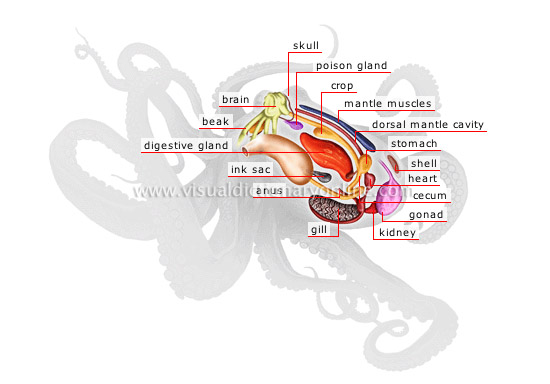anatomy of an octopus
ink sac 
Reservoir containing an ink-producing gland; when threatened, the octopus releases the ink through the siphon into the water to hide its flight.
anus 
Terminal orifice of the digestive tract enabling ejection of fecal matter.
gill 
Respiratory organ located in the dorsal mantle cavity and covered with ciliated cells; muscles help to circulate water through the gills.
kidney 
Organ secreting urine; it eliminates toxic substances from the body.
heart 
Muscular organ helping blood to circulate.
gonad 
Genital gland producing spermatozoa (sperm) or ova (eggs), depending on the sex of the mollusk.
cecum 
Lateral canal located in the anterior portion of the intestine where especially a part of digestion and fermentation take place.
stomach 
Dilated section of the digestive tract preceding the intestine; it receives food to be digested.
shell 
Small internal calcareous structure produced by the mantle; certain species do not have shells.
dorsal mantle cavity 
Chamber formed of folds of the mantle; it contains the main organs, especially the gills, and connects to the outside.
mantle muscles 
Muscles contracting to force water out of the dorsal mantle cavity through the siphon and allowing the octopus to propel itself through the water.
digestive gland 
Organ producing a secretion that contributes to digestion.
crop 
Large sac located beyond the esophagus, where food is held before being digested in the stomach.
poison gland 
Organ producing an acidic secretion that forms the venom, which the octopus injects into its prey through its beak.
beak 
Corneous formation consisting of a jaw capable of crushing, and allowing the octopus to catch its prey and inject it with venom.
skull 
Bony structure enclosing and protecting the brain.
brain 
Main organ of the nervous system; it is located in the head.












